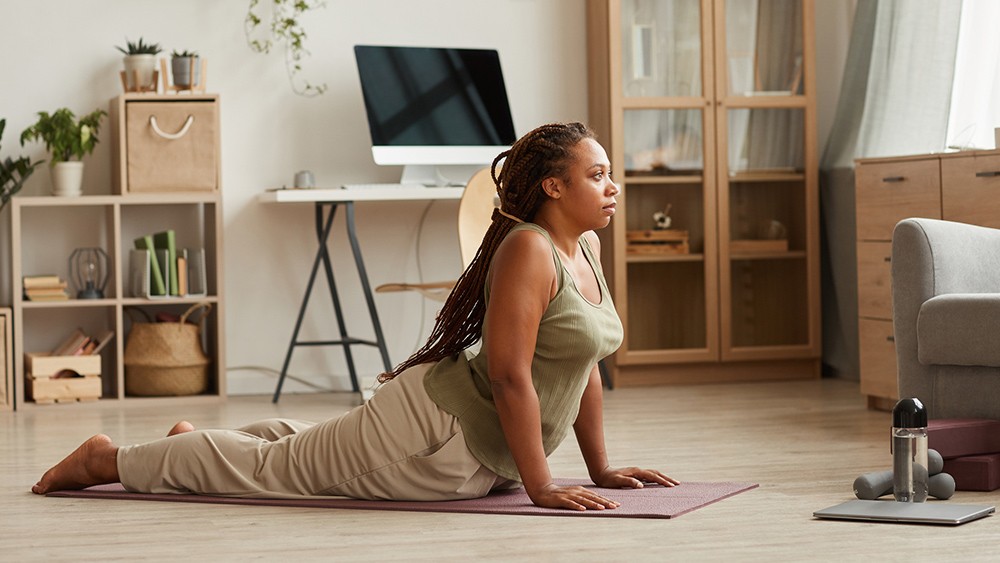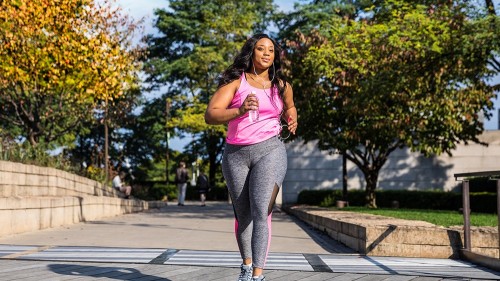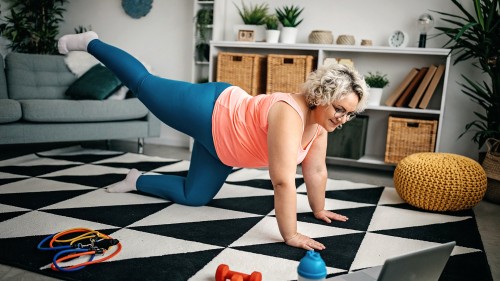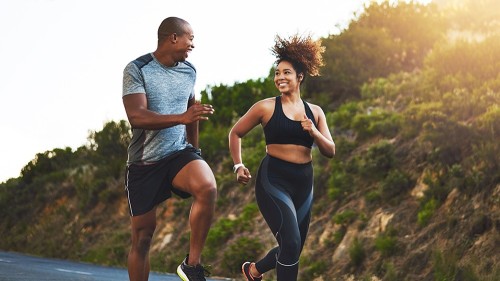Exercise for Beginners: A 6-Step Approach to Getting Active
Last Updated on August 8, 2023
Reviewed by Ana Reisdorf, MS, RD
Regularly exercising is one of the greatest and most impactful things you can do to support your overall health and well-being, no matter your fitness level. Here we discuss a practical approach to help you confidently (and safely) start exercising.


When it comes to exercise, many of us aim for perfection. But the truth is, just moving your body rather than trying to be perfect will benefit your health. Sometimes just walking for 20 minutes a day can be better than nothing. Do what you can to get moving.
It may take some planning and grit, and starting out may feel overwhelming; however, you’ll never look back once you start experiencing the benefits.
To help you get started, we've put together this 6-step approach to exercise.
Step 1: Develop Your Motivation
The most crucial step to exercising is to develop a deep personal sense of why you want to exercise. Exercising regularly comes with challenges, but a deep understanding of the “why” will help you keep going. Unfortunately, this step is often overlooked, which is why many people quit exercising.
Before you start, ask yourself these questions (and write down the answers to keep as a reference for yourself when you need a clear reminder):
- Why do you really want to exercise? After you answer this, ask yourself again, why is this reason important? This will help you get closer to your real why. Getting there might take a few rounds, but attaching a meaningful reason to your exercise is key.
- What will your life be like 2–5 years into the future if you exercise regularly? Imagine your life in as many details as possible and include your deepest thoughts and feelings.
- What will your life be like in 2–5 years if you don’t exercise? Draw on your experience and imagine a future that you want to avoid. Be as honest as you can with yourself.
For additional motivation, consider the many ways that exercising regularly can benefit your health:
Benefits of Exercise
- Helps with Weight Management: Exercise increases the number of calories your body burns (or uses for energy) and decreases your chances of gaining weight. If weight loss is your goal, create a calorie deficit (by reducing the number of calories you eat) and begin a workout regime. (1)
- Supports Your Energy: Exercising regularly improves your energy levels and reduces fatigue. Being physically active helps produce more oxygen to your heart and lungs, resulting in higher energy levels over time. (2)
- Reduces Risk of Certain Diseases: Regular exercise can help you avoid (or reduce chances of) chronic diseases, including cancer, diabetes, and cardiovascular disease. (3)
- Enhances Cognitive Function: Regular exercise may improve your cognitive ability, including your memory and problem-solving skills, whether you’re a younger or older adult. (4, 5)
- Improves Mood and Reduces Stress: Working out can elevate your mood and reduce your stress levels by suppressing and producing certain hormones. Specifically, it can reduce your body’s levels of stress hormones (like adrenaline and cortisol) and instead activate the production of endorphins (or chemicals in the brain that can improve your mood and act as your body’s natural painkillers). (6)
- Improves Sleep: Regular exercise has been shown to improve the quality of your sleep and reduce the time it takes you to actually fall asleep. (7)
- Adds Years to Your Life: Those who are physically active tend to live longer, healthier lives. Research shows moderate physical activity, including walking, can significantly contribute to longevity. (8)
Step 2: Set Goals
After figuring out why you want to exercise, the next step is to determine what you want to accomplish by setting specific goals.
If you’ve never worked out or haven’t in a long time, you may be tempted to start out bold and strong by trying to work out with intensity every day. This may mean working out for an hour or more, loading up on weights that are too heavy for you, or taking an extreme HIIT class before your body is ready. While this may seem like the best initial approach, it often leads to injury and burnout.
A more sustainable approach is to set realistic, measurable, specific, and time-bound goals.
There are two main approaches you can take. You can set a result-oriented goal (for example, losing 20 pounds or doing 30 push-ups). Or you can set a process-oriented goal (such as, “I want to exercise five days a week.”) Both approaches work, and we encourage you to try either or both.
Let's use the result-oriented goal of losing 20 pounds as an example:
- Realistic: A typical healthy rate of losing weight is 1–2 pounds per week. It would not be realistic or sustainable to set a more ambitious goal.
- Measurable: Your weight loss progress could easily be measured by weighing yourself a few times a week. (Tip: Do it at the same time each day for consistency.)
- Specific: Losing 1 pound a week until reaching the target 20-pound loss.
- Time-Bound: It will take 20 weeks (5 months) to reach the target result of 20 pounds lost.
Here’s a process-oriented example focusing on establishing a regular weekly workout routine:
- Realistic: I can realistically work out three days a week for 30 minutes each day without adding stress to my life.
- Measurable: I will keep track of my workout days and duration and reassess every week to see if anything needs improvement or adjustment.
- Specific: I will work out Monday, Wednesday, and Friday after work at 5 pm. I will stick to one particular 3-day bodyweight routine with stretches before and after the workout (we’ll provide a sample below, but you can find many routines online). Every Sunday, after breakfast, I will review my “why” and reassess my weekly workout notes to track my progress.
- Time-Bound: I will stick to this schedule for eight weeks and then reassess to see what can be improved.
Step 3: Design Your Routine
Establishing an exercise routine or picking a workout program beforehand will help you plan your week and save time.
After setting your goals (discussed in the previous step), you can pick a program tailored to reaching them.
There are various types of exercises you can choose from. They may include aerobic (also known as cardio), strength training, high-intensity interval training (HIIT), stretching, and balance. This combination can help maintain or improve your cardiovascular health, strength, and overall health and functioning.
Different Types of Exercise
From rigorous boot camps to gentle yoga, there are many different types of exercises you can choose from.
- Aerobic: Also known as cardio, this exercise involves cardiovascular conditioning to strengthen your heart and lungs. This type of exercise can also increase your endurance. For example, if you’re out of breath after climbing a set of stairs, your body will likely benefit from aerobic exercise. Examples include walking briskly (power or speed walking), jogging, running, dancing, cycling, and swimming.
- Strength Training: Also called resistance training, strength training involves using your body weight or tools (like free weights or resistance bands) to increase muscle mass, strength, and endurance, which we lose as we age. Examples include weightlifting, utilizing a weight machine, sit-ups, push-ups, and planking.
- High-Intensity Interval Training (HIIT): HIIT involves repetitions of short bursts of high-intensity exercise followed by low-intensity exercises or rest periods. While HIIT is highly effective, it may not be for everyone, especially if you’re just starting out. Also, if you have any underlying medical conditions, it’s important to first consult your physician.
- Stretching: Routinely stretching your muscles will make them longer and more flexible, increasing your range of motion and reducing pain and the risk of injury. Examples include muscle-stretch movements like the standing hamstring stretch or triceps stretch and various yoga poses.
- Balance: Balance exercises will strengthen muscles to improve coordination, which can help with stability and fall prevention. Balancing on one leg, core-strengthening activities, and Tai Chi are some examples of balance exercises.
Sample Exercise Plan
A typical beginner exercise routine should include two to three days of cardio and two days of strength training.
However, these workouts can be merged if you do not have five days to set aside for exercise. Flexibility training, or stretching, should be done before and after every workout.
With most beginner exercise programs, you will start working out at low to moderate intensity, depending on your individual needs.
Tip: The “talk test” is a simple way to gauge the intensity of your workouts. For example, you can talk without issues during a low-intensity workout. During a moderate-intensity activity, you can talk but not have the capacity to sing. During a high-intensity workout, you cannot say more than a few words without pausing for a breath.
The following is a sample beginner exercise schedule for one week. You can repeat this routine for the first 4 weeks, slightly increasing reps and plank duration every week, or reducing rest time between sets.
Monday
Five minutes of stretching and 20–25 minutes of moderate-intensity cardio. This may include brisk walking, stationary bike, or swimming laps. (Cardio activities could be modified to include a diverse range of activities.) Finish off with a five-minute post-workout stretch.
Tuesday
Five minutes of pre-workout stretching (sample).
20 minutes of strength training, which includes:
- 3 sets of 8–10 bodyweight forward lunges per leg, with 30-second rest between sets
- 1-minute rest
- 3 sets of 10–12 bodyweight squats (modification: sit and stand up in a chair), with 30-second rest between sets
- 1-minute rest
- 3 sets of 8–12 push-ups (modification: knee push-up), with 30-second rest between sets
- 1-minute rest
- 3 sets of 30-second elbow plank, with 30-second rest between sets
Five minutes of post-workout stretching (sample).
Wednesday
Thirty minutes of gentle yoga or full body stretch.
Thursday
Five minutes of stretching and 20–25 minutes of moderate-intensity cardio. This may include brisk walking, an outside bike ride, or swimming laps. (Cardio activities could be modified to include a diverse range of activities.) Finish off with a five-minute post-workout stretch.
Friday
Five minutes of pre-workout stretching.
15 minutes of strength training, which includes:
- 3 sets of 8–10 bodyweight reverse lunges per leg, with 30-second rest between sets
- 1-minute rest
- 3 sets of 20 jumping jacks, with 30-second rest between sets
- 1-minute rest
- 3 sets of 8–12 push-ups (modification: knee push-up), with 30-second rest between sets
- 1-minute rest
- 2 sets of 20-second side plank on each side, with 30-second rest between sets
Finish off with five minutes of post-workout stretching.
Saturday
Rest day (optional 10–20 minutes of mobility exercises or full body stretch).
Sunday
Five minutes of stretching and 20–25 minutes of moderate-intensity cardio. This may include brisk walking, an outside bike ride, or swimming laps. (Cardio activities could be modified to include a diverse range of activities.) Finish off with a five-minute post-workout stretch.
Learn Proper Form
Learning the proper form before you start is essential to maximize the benefits of each exercise, feel confident, and avoid injury.
If you’re just starting out with any of the forms of exercises listed above, YouTube is a great resource. Netflix also recently started adding workout videos to its inventory.
Once you watch some videos, observing yourself in the mirror (or having a friend watch you) may be helpful as you’re practicing the exercise and building up your confidence.
The Key to Long-Term Success Is to Find Something You Enjoy
Regular exercise will provide more health benefits than periodic, high-intensity workouts, so choosing something you enjoy will help with sustainability.
If you love the outdoors, try walking, hiking, or cycling. If you love dancing, incorporate a cardio dance class. If you hate running, you don’t need to do it. There are endless workouts to choose from that will help you meet your goals and that you won’t necessarily dread doing.
Try multiple exercise types to see which one you gravitate towards. Working out doesn’t necessarily have to include sweating it out at the gym.
Step 4: Prep Your Equipment and Accessories
No, you don’t have to buy the most expensive equipment, high-end home gyms, or even get a membership to the most prestigious gym, especially when you’re just starting out.
However, the following essential gear will help enhance your various exercise routines and make the process more enjoyable and sustainable:
- Supportive and comfortable shoes to help mitigate your workout’s impact on your joints and ligaments.
- Comfortable and breathable athletic clothes.
- A quality yoga mat to prevent you from slipping, provide padding for your knees, and keep the sweat off your floor.
- An insulated water bottle to help keep you hydrated during workouts and throughout the day.
- Fitness ball (not required to start, but a good addition for stretching and balance exercise).
- Light, medium, and heavy dumbells (not necessary to start, but will come in handy once you start progressing).
Step 5: Establish Your Baseline and Keep Retesting at Regular Intervals
It is essential to establish your baseline to know where you are starting out.
Key metrics to track are:
- Body Mass Index (BMI)
- Weight
- Push-ups
- Bodyweight squats
- Elbow plank
- Heart rate after a mile of brisk walking
When taking your baseline for push-ups, squats, and elbow plank, approach it as a regular workout with a pre-workout stretch/warmup and a post-workout stretch. Try two sets of each exercise, with a minute of rest in between, and use your best set.
Retest yourself every 4–6 weeks to track your progress. Seeing improvements will help keep you motivated, especially when starting out. Remember that the progress will not always be linear as you continue on your exercise journey.
If your baseline retest does not show an acceptable improvement, don’t be discouraged — it is still a valuable signal indicating that it’s time to increase the intensity of your workouts. For example, it may be time to increase weight, reduce rest time between sets, or even try different exercises.
Step 6: Getting Started and Important Considerations
After working through the previous five steps, you should have everything you need to get started. The next step is to get started.
Set a Schedule and Address Logistics
Set a target start date and schedule your first week in your calendar with specific start and end times. Figure out the specific place where you will work out and, if needed, get it ready. Identify any potential obstacles that may get in the way and try to resolve them as much as possible.
Also, schedule 15–30 minutes at the end of the week to reassess the current week and plan for the next week. This is also a good time to reflect on your progress and hard work and review your “why” and goals. Rinse and repeat this process every week.
Reward Yourself
You may want to consider giving yourself rewards after completing a workout or when you reach a new milestone, especially in the earlier stages. In fact, research shows that rewards motivate people and can help increase their physical activity levels. (9)
Choosing non-food rewards like taking a bubble bath, purchasing a new book, treating yourself to a pedicure or manicure, or even watching your favorite TV series can help keep you on track physically and mentally.
Good Nutrition
Excellent nutrition is essential to fuel our bodies for physical activities, including exercise and recovery. It’s important to consume a variety of fruits and veggies (try to add fruits and veggies from all the rainbow colors).
Healthy fats are also a great addition, including avocados, seeds and nuts, and fatty fish (salmon, sardines, tuna). Bananas are a great source of fuel before and after your workout.
You can learn more from our article on what to eat before a workout here.
Other Tips and Considerations When Starting Out
- Soreness is normal, but pain isn’t. Listen to your body, and if you feel pain, stop exercising. The pain you’re feeling could be a sign of muscle exhaustion or caused by an injury.
- Find workout buddies in your circle of friends, family, and coworkers. Having someone to share your workouts with will keep you both motivated and accountable.
- Make sure you remain hydrated before, during, and after your workouts. This will ensure that you’re able to maximize your strength and endurance.
- Be gentle and patient with yourself. Every day is not going to look perfect, and that’s okay. If you miss a day, a week, or even a month of working out, it’s never too late to get back to it.
- Track your progress. As mentioned, don’t forget to track your workouts and review everything during your weekly assessment sessions.
At WellnessVerge, we only use reputable sources, including peer-reviewed medical journals and well-respected academic institutions.
- Role of Physical Activity for Weight Loss and Weight Maintenance:
https://www.ncbi.nlm.nih.gov/pmc/articles/PMC5556592/ - Effects of Exercise to Improve Cardiovascular Health - PMC:
https://www.ncbi.nlm.nih.gov/pmc/articles/PMC6557987/ - Physical Activity as a Determinant of Successful Aging over Ten Years:
https://www.nature.com/articles/s41598-018-28526-3 - White matter microstructure mediates the association between physical fitness and cognition in healthy, young adults:
https://www.nature.com/articles/s41598-019-49301-y - Moderate Exercise Improves Cognitive Function in Healthy Elderly People: Results of a Randomized Controlled Trial - PubMed:
https://pubmed.ncbi.nlm.nih.gov/34733346/ - Association between physical exercise and mental health in 1·2 million individuals in the USA between 2011 and 2015: a cross-sectional study - PubMed:
https://pubmed.ncbi.nlm.nih.gov/30099000/ - Exercise can improve sleep quality: a systematic review and meta-analysis:
https://www.ncbi.nlm.nih.gov/pmc/articles/PMC6045928/ - Association of Daily Step Count and Step Intensity With Mortality Among US Adults:
https://pubmed.ncbi.nlm.nih.gov/32207799/ - Little rewards, big changes: Using exercise analytics to motivate sustainable changes in physical activity:
https://www.researchgate.net/publication/336993281_Little_rewards_big_changes_Using_exercise_analytics_to_motivate_sustainable_changes_in_physical_activity






